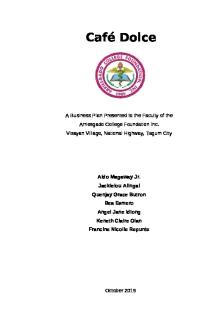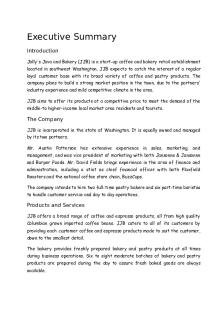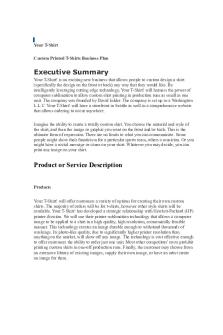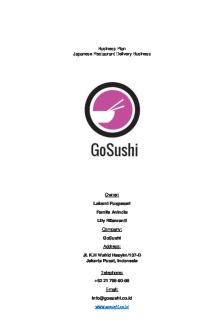Business Plan - Go Sushi Japanese Restaurant PDF

| Title | Business Plan - Go Sushi Japanese Restaurant |
|---|---|
| Author | Laksmi Sari |
| Pages | 36 |
| File Size | 1.1 MB |
| File Type | |
| Total Downloads | 460 |
| Total Views | 809 |
Summary
Business Plan Japanese Restaurant Delivery Business Owner: Laksmi Puspasari Famila Anindia Lily Ribawanti Company: GoSushi Address: Jl. K.H Wahid Hasyim/137-D Jakarta Pusat, Indonesia Telephone: +62 21 798-90-88 Email: [email protected] www.gosushi.co.id Table of Contents 1. Executive Summary ........
Description
Business Plan Japanese Restaurant Delivery Business
Owner: Laksmi Puspasari Famila Anindia Lily Ribawanti Company: GoSushi Address: Jl. K.H Wahid Hasyim/137-D Jakarta Pusat, Indonesia Telephone: +62 21 798-90-88 Email: [email protected] www.gosushi.co.id
Table of Contents 1. Executive Summary .......................................................................................................... 4 2. Description of Business ..................................................................................................... 5 2.1.1 SWOT Analysis ..................................................................................................... 5 2.2 Industry background .................................................................................................... 6 2.3 Goals and Potential of the Business and Milestone ..................................................... 7 2.4 Uniqueness of the product and service ........................................................................ 8 2.5 Company ownership/legal entity .................................................................................. 9 2.6 Location ....................................................................................................................... 9 2.7 Manufacturing ............................................................................................................ 10 2.8 Services..................................................................................................................... 10 2.9 Management ............................................................................................................. 11 2.9 Financial management .............................................................................................. 11 3. Marketing ........................................................................................................................ 12 3.1 Market Research ....................................................................................................... 12 3.1.1 Mission and Objectives ....................................................................................... 12 3.1.2 Target market segment strategy.......................................................................... 13 3.1.3 Market Size and Trends ...................................................................................... 13 3.1.4 Competition ......................................................................................................... 14 3.2 Marketing Strategy .................................................................................................... 16 3.3 Advertising and Promotion ......................................................................................... 18 3.4 Pricing ....................................................................................................................... 18 4. Operation ........................................................................................................................ 20 4.1 Production process .................................................................................................... 20 4.2 Location ..................................................................................................................... 21 4.3 Human resources ...................................................................................................... 22 4.4 Inventory.................................................................................................................... 22 4.5 Payment system ........................................................................................................ 23 5. Management ................................................................................................................... 24 5.1 Management team..................................................................................................... 24 6. Finance ........................................................................................................................... 25 6.1 Required fund ............................................................................................................ 25 6.2 Fixed operating cost .................................................................................................. 26 6.3 Project sales forecast ................................................................................................ 27 6.4 Projected income statement ...................................................................................... 29 6.5 Projected cash flow ................................................................................................... 30 6.6 Projected balance sheet ............................................................................................ 31 6.7 Break even analysis .................................................................................................. 32 BUSINESS PLAN – GOSUSHI 2015
LAKSMI PUSPASARI
7. Critical risk ...................................................................................................................... 32 7.1 Potential problem....................................................................................................... 32 7.2 Obstacles and risk ..................................................................................................... 32 7.3 Alternative cause of action ......................................................................................... 33 8. Milestone Schedule ......................................................................................................... 34 References ......................................................................................................................... 35
BUSINESS PLAN – GOSUSHI 2015
LAKSMI PUSPASARI
1. Executive Summary The business plan in this document is an innovative ideas of Japanese food business with delivery service. Nowadays, in Indonesia, especially in Jakarta, Japanese food has become a trend in society. Japanese food brings a lot benefits to consumers. For Instance, the famous sushi contains omega 3 because it is from seafood which is healthy and good for brain intelligence. There are a lot of restaurants that serve Japanese food. It can easily be found in the shopping centre, malls, and etc. And most of them offered a similar services. GoSushi as a newcomer in the Japanese culinary food offers a special services to customers, where consumers can order our products through our delivery services. GoSushi deliver the orders directly to the destination. For instance, at school, office, or home. Furthermore, with the Jakarta traffic conditions, it is our opportunity to attract the Indonesian market. The menu offered by GoSushi is similiar with other Japanese restaurant. We divided the menu into 11 groups consist of sushi, sashimi, sushi roll, ship, fried, dessert, sushi combo, sashimi combo, salad, ramen and udon. GoSushi target consumer is a middle class income and above who love to try Japanese food. GoSushi pricing strategy we do cost based pricing, and it is still affordable for the targeted consumers. GoSushi founded by three members. We started this business with an initial capital of IDR 150.000.000.Which funded from each owner. GoSushi operates in Jakarta, especially central Jakarta. To run our business, we ensure that GoSushi have a legal entity in the form of a limited liability company (LLC) and has registered to MUI halal certification. This is to improve consumer trust in our products and services. The mission of GoSushi is: “Provide Japanese food with a delivery service that provides the best quality and excellent service with suits the Indonesian market.” The vision of GoSushi is: “become the largest Japanese food restaurant in Indonesia. “ .
BUSINESS PLAN – GOSUSHI 2015
LAKSMI PUSPASARI
2. Description of Business 2.1 General Description of Business GoSushi is a start-up business in the food industry. GoSushi was established in June 2015. It is run by 3 investors with the equal ownership. GoSushi offered Japanese foods especially Sushi with high quality and affordable prices. We offers a unique concept, if normally consumers wants to eat sushi, we had to come directly to the restaurant, then GoSushi provide on a delivery service concept. So sushi can be enjoyed everywhere, at home, school or office. The main idea of this business came up when we want to eat sushi, we often had to go to the nearest mall to find a Japanese restaurant. From that moment, we found a new idea, would not it be efficient if sushi can be deliver directly to the consumer, it is easier and efficient for consumers to satisfy their needs. And we are challenged to establish a businesses that meet the needs above. Why sushi? Sushi is one of the famous Japanese food. Nowadays in Indonesia, sushi has become a trend in the society. A lot of people liked to eat sushi. Sushi also has a benefits for the body. We believe a business in the food industry especially sushi is quite promising. The vision of our company is: become the largest Japanese food restaurant in Indonesia. And our mission is: ‘’ to serves Japanese food with high quality that suits with Indonesian market.’’
2.1.1 SWOT Analysis Table 2.1 SWOT Analysis
Strength
Provide good delivery service to consumers Provide a high quality product Competitive prices Friendly, fast, and consistent service
Weakness
Lack of experience in food industry Lack of consumers because of new business Lack of human resources
Opportunities
Growth of Japanese food trends Improvement of living standards in Jakarta's society The delivery service become an alternative in a dense city like Jakarta Low number of competitors offered the delivery service
Threats
Competitors with top notch Japanese restaurant Increase price of imported raw materials Unpredictable Jakarta's road condition Increase of gasoline price
BUSINESS PLAN – GOSUSHI 2015
LAKSMI PUSPASARI
2.2 Industry background Southeast Asia is one of the world’s fastest growing market. There are plenty business in the food industry. It is shows that the industry are still on demand and it is very promising if a company could managed the business well. Everyone definitely needs food, and today people are looking for new and unique types of food to eat. This has led to a rise in a culinary specialty for example GoSushi a Japanese food restaurant which delivers a new way to enjoy the food. We believe GoSushi will meets the market needs and able to achieve success.
Table 2.2 Industry Developments
Source: http://aabs2015.kadinindonesia.org/wp-content/uploads/2015/04/Bahan-Business-Dialoque-Session-IIAgriculture_AABS.pdf
From the chart above from the chamber of commerce (KADIN) year 2013 until 2014 it is shown that food industry has the highest contribution to country’s GDP compared to other industries. And by this, we believe that we can conquer the market. As time goes by, sushi became more popular in Japan and everyone can enjoy the food. Sushi has gone global, sushi products or restaurants almost be found across United States, United Kingdom, Europe and even Asia. Especially in Indonesia. In Indonesia, sushi became popular when it was brought by a famous sushi restaurant, Sushi Tei, in 2003. Since then, it turns out the society are enthusiast for sushi. Indeed, prior to that before Sushi Tei entered Indonesia there have been several sushi restaurant, but the price is very high and only those of the upper classes who can enjoy it. Sushi Tei targeted people for the upper middle class so that more people are able to enjoy the food. Then many businesses stand to follow the success of Sushi Tei, such as Sushi Groove, Kiyadon Sushi, BUSINESS PLAN – GOSUSHI 2015
LAKSMI PUSPASARI
and the other small business that operates in the food court or stalls that offers cheaper price. Many of the sushi merchant’s in Indonesia are being creative by modifying flavors and types of sushi making it more suitable for Indonesian taste. This is because the local people tend to follow the trend of eating sushi, but it turned out to be different than the original Japanese sushi.
2.3 Goals and Potential of the Business and Milestone Milestone is very important to measure our business vision and goals become the largest Japanese food restaurant in Indonesia. To achieve this goals, GoSushi have to expand new branches which more accessible and known by consumers. Here is a milestone of GoSushi for the next 3 years: Table 2.4 Milestone
No. 1. 2. 3. 4. 5. 6.
Details information Open a new branch in West Jakarta Open a new branch in South Jakarta Open a new branch in East Jakarta Open a new branch in North Jakarta Open a new branch in BODETABEK areas Expand the business throughout Java
BUSINESS PLAN – GOSUSHI 2015
Completion 6 Months 6 Months 6 Months 6 Months 12 Months 12 Months
LAKSMI PUSPASARI
2.4 Uniqueness of the product and service Our main products that we offer is Japanese food. For example: sushi, udon and ramen. The advantages of our products that we provide a fresh and delicious food, and we also provide delivery service to satisfy customer needs. The price that we offer also affordable that still meets our target market, middle to upper middle income customers. Here are the types of menus offered by GoSushi: Sushi The original form of sushi. It is made of rice and on the top with the fish egg, squid, avocado or nori. Price: IDR 28.000 /4pcs
Sashimi Sashimi is one of Japanese food. It is thinly sliced raw meat such as seafood. It is slightly different than sushi because it is usually prepared uncooked (raw). The sauce dressings such as soy sauce, grated fresh ginger, and wasabi paste. Price: IDR 25.000 /4pcs
Sushi roll (nigiri) Sushi roll is another type of Japanese food. It consisted of nori, rice and fish, cucumber, shredded, chicken, avocado, or etc. The difference between sushi and sushi roll only on the form of the food. Price: IDR 25.000-35.000 /6pcs
Fried sushi Fried sushi is also our best selling products. For example: tempura, spring rolls, meatballs seafood, etc. The main ingredient of tempura is shrimp. Price: IDR 25.000 /3pcs
Dessert We also offers a sweet dishes such as sorbet, ice cream and mochi. Price: IDR 15.000-25.000
Sushi combo Sushi combo is one package sushi that can be mix based on consumer’s choices. . Price: IDR 35.000-50.000 /20-25pcs
Sashimi combo Sashimi combo is one package sashimi that can be mix based on consumer’s choices. Price: IDR 40.000-60.000 /10-15pcs
BUSINESS PLAN – GOSUSHI 2015
LAKSMI PUSPASARI
Salad We offers a fresh garden salad with assorted dressings. Price: IDR 15.000-25.000
Udon Udon is a Japanese noodles. The size of the noodle is thicker than usual. The flavor of broth and topping are varies for example, with seafood, chicken, mushroom and vegetables. Price: IDR 30.000
Ramen Ramen is a Japanese noodles. The size of the noodles is normal like any other noodles. We provide various variants of ramen with seafood, chicken, mushroom, and vegetables. Price: IDR 30.000
GoSushi also provide a special package as shown in the menu. We also offers our favorite products which are udon and ramen. GoSushi always develop a creative menu, for example we have created a special dishes for a vegetarian. For the delivery service, we strive to give a good service for consumers. Prior to that, we do the pre-order system a night before the delivery day. When we have received the orders, we will make sure that the order will be delivered on the agreed time. This is also to ensure our product will still fresh and in a good condition. Besides sushi, GoSushi offers other varieties of Japanese food, such as ramen, udon, curry, and etc. The order will be safely packed in a box to ensure that our product is still in a good condition until it reached the destination. GoSushi also offer packages for corporate for meetings or any other events.
2.5 Company ownership/legal entity Opening a new business has its own legal considerations. GoSushi have a legal entity in the form of a limited liability company (LLC) where provides a separate legal entity and can help protect founders personal assets from risk. We obtain Halal certification from MUI (Majelis Ulama Indonesia). This certificate plays an important role especially in Moslem religion. With this certification, it would not makes any doubt in consumer’s mind to buy our products.
2.6 Location GoSushi located in Central Jakarta as an initial operating field. Jakarta is widely known as the capital and largest city in Indonesia with a high urban population, we think it is a good BUSINESS PLAN – GOSUSHI 2015
LAKSMI PUSPASARI
idea to start the business. With the society’s culture it is even easier for GoSushi to enter the market.
2.7 Manufacturing The transportation of our food delivery, we decided to use a motorcycle. It will be more efficient and convenient instead of a car. The vehicle will be equipped with a special container delivery box. The box will be designed to maintain the food stay fresh and warm and protect from the contamination during the trip. The messenger (courier) of GoSushi will wear a proper uniform and supported with a training about the product knowledge and handling consumers. The consumers of GoSushi is not limited by gender or age. Everyone can enjoy our products. However, GoSushi targeting middle to upper middle income consumers. Our selling prices are ranging from IDR 15.000 – 60.000. With the delivery system, GoSushi have a minimum order to avoid losses due to high delivery costs. The minimum order is IDR 75.000. GoSushi have two different order systems, offline and online. Offline, we will distribute a brochure that includes our menus and the contact number. Consumers can order by directly call the number and assist by GoSushi representative. While online, we built our own website where the consumers could easily order in anytime and anywhere. New customers just have to register their personal data and choose the order, after completed we will confirm and deliver the order. It is important to keep the consumers personal database for their next purchase order and also the promotion. To maintain the product quality in our restaurants, we will cooperate with the suppliers of raw materials. GoSushi ensure to use only the best ingredients, fresh, and guaranteed quality. The raw material of making a sushi are: Japanese rice, seafood, nori or dried seaweed, vinegar, vegetables, and fish eggs. These materials always available in our kitchen. GoSushi payment system can be done in cash or by transfer to a bank account. Our next plan, we are trying to cooperate with the bank hence we can have an EDC (Electronic Draft Capture) also known as a card swipe machine. It is also easier for consumers who wants to pay pay using debit cards, credit cards, or Flazz Cards.
2.8 Services In order to create a good customer relationship, GoSushi offers a friendly, fast and consistent service to our customers. We also accommodate our employees by give them a training such as literacy and interpersonal skills training. Which we think both of those trainings are important to create a solid and strong team within the employees and it will definitely affect employees views about how to serves customers better. To maintain BUSINESS PLAN – GOSUSHI 2015
LAKSMI PUSPASARI
customer relationship, we offered a loyalty programs, such as loyalty card. We invite customers to sign up for our loyalty card program and promote them about a benefit and bonus of merchandise or products by spending some minimum amount. Our key activit...
Similar Free PDFs

Restaurant sample business-plan
- 34 Pages

Business plan - Thai Restaurant
- 20 Pages

Fast Food Restaurant Business Plan
- 20 Pages

CUE- Business-PLAN - Business plan
- 10 Pages

Business-Plan - Business plan Enc
- 48 Pages

Business Plan
- 26 Pages

Business PLAN
- 3 Pages

Business PLAN
- 21 Pages

Business PLAN
- 10 Pages
Popular Institutions
- Tinajero National High School - Annex
- Politeknik Caltex Riau
- Yokohama City University
- SGT University
- University of Al-Qadisiyah
- Divine Word College of Vigan
- Techniek College Rotterdam
- Universidade de Santiago
- Universiti Teknologi MARA Cawangan Johor Kampus Pasir Gudang
- Poltekkes Kemenkes Yogyakarta
- Baguio City National High School
- Colegio san marcos
- preparatoria uno
- Centro de Bachillerato Tecnológico Industrial y de Servicios No. 107
- Dalian Maritime University
- Quang Trung Secondary School
- Colegio Tecnológico en Informática
- Corporación Regional de Educación Superior
- Grupo CEDVA
- Dar Al Uloom University
- Centro de Estudios Preuniversitarios de la Universidad Nacional de Ingeniería
- 上智大学
- Aakash International School, Nuna Majara
- San Felipe Neri Catholic School
- Kang Chiao International School - New Taipei City
- Misamis Occidental National High School
- Institución Educativa Escuela Normal Juan Ladrilleros
- Kolehiyo ng Pantukan
- Batanes State College
- Instituto Continental
- Sekolah Menengah Kejuruan Kesehatan Kaltara (Tarakan)
- Colegio de La Inmaculada Concepcion - Cebu






